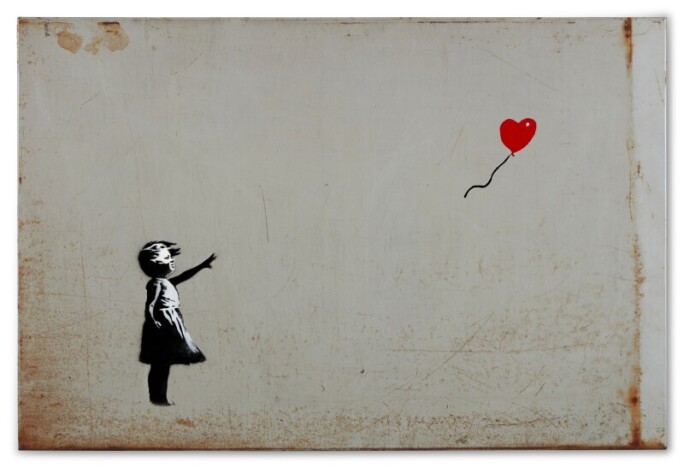E ver since his first spray-painted works began appearing on the streets of Bristol in the 1990s, Banksy combined art with activism. In fact, the two are inseparable as his work commands as much of a following in the art world as it does within the activism space.
The famously-anonymous artist might keep his identity under wraps but his work is unapologetically political, whether it is transforming the House of Commons into a hall of apes, turning Molotov cocktails into bouquets of flowers or dumping shopping trolleys into Monet’s Japanese gardens. For over two decades, he has tackled climate change, immigration crises, Brexit, political corruption, consumerism and terrorism.
Three Classic Works by Banksy | From the Robbie Williams Collection
In Sotheby’s upcoming NOW Evening sale, three examples from The Collection of Robbie Williams illustrate just how consistently Banksy’s work subverts expectations, challenges the status quo and shines a light on the marginalised and the mistreated. Williams himself says “These pieces combine three things I love: hip-hop culture, naughtiness and comedy. I thought they were the best thing I’d seen in the art world…”.
Girl With Balloon (2004) is perhaps one of the most recognisable motifs in the contemporary art world and one whose history became forever entwined with Sotheby’s in October 2018 when, as the hammer fell on the sale of one version of the work, the canvas slid through a shredder hidden in the base of the frame. The work was only partially destroyed and was instead given a new title: Love is in the Bin, which sold for £18,582,000 in October 2021.
'Girl With Balloon can credibly be called the most famous image by the world’s most famous living artist.'
In this particular example, the image of the young girl, her arm outstretched towards a cherry red heart-shaped balloon drifting away, is executed in spray paint on metal. This medium recalls Banksy’s origins in street art - Girl With Balloon first appeared as a mural on Waterloo Bridge in 2002. In 2017, it was voted the nation’s favourite artwork in a poll of UK art writers, and can credibly be called the most famous image by the world’s most famous living artist.
“Imagine a city where graffiti wasn’t illegal, a city where everybody could draw whatever they liked. Where every street was awash with a million colours and little phrases. Where standing at a bus stop was never boring. A city that felt like a party where everyone was invited, not just the estate agents and barons of big businesses. Imagine a city like that and stop leaning against the wall – it’s wet”
Police officers feature regularly in the artist's work, a nod to the illegality of his street art. Although he initially preferred drawing and painting freehand, his signature stencilling technique was borne of a necessity to produce works speedily with minimum visibility to curious onlookers.
The best-known police figures in the Banksy canon are the canoodling constables in Kissing Coppers. two policemen entwined in a passionate kiss. The work originated in 2004 on the wall of the Prince Albert pub in Brighton, where it remained in situ for seven years until 2011, when the building's owners decided to sell the mural, and funnel the proceeds towards a revamp. Alongside Girl With Balloon, this is one of Banksy’s most famous images..
As with so much of Banksy’s oeuvre, Kissing Coppers is designed to provoke, challenge and play with its audience, highlighting the hypocrisy that plagues authority, law enforcement and the British establishment. Homosexuality remained illegal in the United Kingdom until 1967 but was not fully decriminalised until 2013. Gay marriage was not made legal until 2014.
As well as his signature street art, another facet of Banksy’s guerilla artistry was the Vandalised Oil series, in which he subverted the solemn respect granted to gilt-framed oil paintings. In the early 2000s, he would often illegally install his own works into museums and galleries to see how long they might pass unnoticed.
The series fizzles with the typically puckish humour characteristic of Banksy, common to all his concepts, and which adds an edge to his piercing social commentary. It places him as a contemporary artist in direct conversation with what has come before, satirising the fears and worries of the establishment and asking profound questions about what kinds of art we value.
In the case of Vandalised Oil (Choppers), the artist addresses the terrifying technology of modern warfare, huge military helicopters bearing down ominously on an parody of a peaceful, bucolic landscape. Executed in 2006, with the messy aftermath of the US-led war in Iraq very much in the public eye, Banksy's black humour and visual irony caught the public's mood perfectl, echoing the zeitgeist yet and giving shape to the frustration and anger felt by millions worldwide.
As with Girl With Balloon and Kissing Coppers, Vandalised Oil (Choppers) encapsulates Banksy’s unique take on a very British vernacular, that uses lyrical imagery to penetrate society's veneers and, rather like a modern-day Hogarth, explores the dark undersides of contemporary life. These three works sum it all up - artistic panache, sly irreverence and a fierce passion for justice and truth. His oft-imitated, never-equalled visual language emerged from the streets but is enriched by a multitude of British cultural reference points, from street art to Old Masters, Pop to Conceptualism. In surveying this trio of works, we find proof that Banksy's unique status as 21st century chronicler, satirist, artist and pioneer is truly unparalleled.







